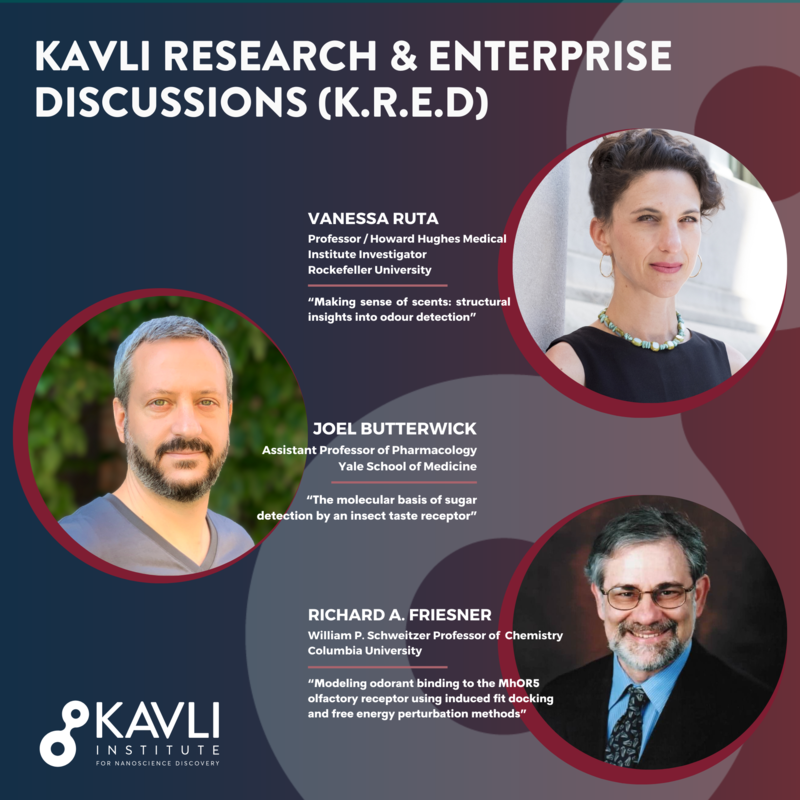Kavli Research & Enterprise Discussions (K.R.E.D)
Kavli Research & Enterprise Discussions (K.R.E.D)
Our Kavli Research and Enterprise Discussion (K.R.E.D) will be given by Professor Vanessa Ruta from the Rockerfeller University, Professor Richard A. Friesner from the Columbia University, and Associate Professor Joel Butterwick from Yale School of Medicine.

Date: 22 April 2024
Time: 14:00
Room: Phase 2 - Seminar Room 20-138
This is an event for University staff only.
Professor Vanessa Ruta's Talk is entitled “Making sense of scents: structural insights into odour detection”
Her abstract and biography are below.
Abstract
Olfactory systems must detect and discriminate an enormous diversity of chemicals in the environment. To contend with this challenge, diverse species from humans to insects, have converged on a common strategy in which odor identity is encoded through the combinatorial activation of large families of olfactory receptors, thus allowing a finite number of receptors to detect an almost infinite chemical world. Our lab has been using the insect olfactory receptors as a window into the structural logic of odour detection. I will discuss recent work that shed light on the architecture, function, and evolution of this receptor family and how they confer insects with the ability to navigate a complex chemical world.
Biography
Vanessa Ruta received her B.A. in chemistry from Hunter College and her Ph.D. from The Rockefeller University, where she carried out her thesis in Roderick MacKinnon’s lab. After conducting her postdoctoral research in Richard Axel’s lab at Columbia University, she returned to Rockefeller in 2011 to start her independent group that studies olfaction across different levels, from the structural basis of receptor detection to the neural algorithms of olfactory navigation. She is currently a professor and a Howard Hughes Medical Institute Investigator. Ruta has received multiple honors and awards, including a MacArthur Fellowship and an NIH Director’s New Innovator Award, the Larry Katz Award, a McKnight Scholar, a Pew Biomedical Scholar, and a New York Stem Cell Foundation–Robertson Neuroscience Investigator.
Associate Professor Joel Butterwick's talk is entitled “The molecular basis of sugar detection by an insect taste receptor”
His abstract and biography are below.
Abstract
Sweet taste receptors serve the essential role of identifying necessary nutrients, while also contributing to the pleasurable perception of consuming sweet foods. Here, I will focus on an exemplary ionotropic gustatory receptor, Gr9 from the silk moth. We determined structures of Gr9 in multiple gating states—alone or bound to either D-fructose or the non-activating sugar L-sorbose—offering a unique entry point to investigate the biophysical basis for sugar discrimination by this receptor. While both sugars can bind the receptor, only D-fructose can both fit into the ligand-binding pocket and simultaneously induce a conformational change in Gr9, thereby coupling ligand binding to pore opening. Thus, the chemical specificity of Gr9 is an emergent property arising from a combination of receptor-ligand interactions and allosteric coupling between the pocket and the ion channel pore. By focusing on a chemoreceptor that is activated by a single ligand, we are able to derive a novel model for chemoreceptor function whereby coarse chemical tuning is governed by the size and chemical characteristics of the pocket, whereas fine-tuning of receptor activation is achieved through the selective engagement of an allosteric pathway that controls ion conduction. Our studies provide a foundation for understanding how evolutionary selection can tune the activity of receptors by acting beyond the ligand-binding pocket, and how related sugars may be discriminated.
Biography
Joel obtained his undergraduate degree from the University of Alberta, Canada, and his Ph.D. from Columbia University. He received postdoctoral training in the MacKinnon and Ruta Laboratories at The Rockefeller University before joining the Department of Pharmacology at Yale in 2020. As a postdoc, Joel used single-particle cryo-electron microscopy to determine the first high-resolution structure of an olfactory receptor, the insect Orco. At Yale, Joel is continuing to study smell and taste receptors to elucidate the elementary principles of chemosensory detection.
Professor Richard A. Friesner's talk is entitled: "Modeling odorant binding to the MhOR5 olfactory receptor using induced fit docking and free energy perturbation methods"
His biography is below.
Biography
Richard A. Friesner is a computational chemist whose work is focused on the development of methods for quantum chemistry, quantum dynamics, biomolecular simulation, and structure based drug discovery. Key innovative software programs from his laboratory include Jaguar (quantum chemistry), Glide (protein-ligand docking), WaterMap (elucidation of active site water structure), OPLS3 (force field), and FEP/REST (protein-ligand binding affinity), all of which are widely used in the pharmaceutical industry. Applications studies include enzymatic catalysis in metalloenzymes such as methane monooxygenase, electron transfer and migration in solar energy conversion systems, and investigation of a wide range of protein-ligand complexes. He received his BS degree in chemistry from the University of Chicago in 1973, and obtained his PhD in 1979 at the University of California, Berkeley. He was then a postdoctoral fellow at the Massachusetts Institute of Technology from 1979-1982. He joined the Chemistry Department at the University of Texas at Austin in 1982 as an Assistant Professor, and in 1990, he became Professor of Chemistry at Columbia University, where he is currently the William P. Schweitzer Professor of Chemistry. He is a Fellow of the American Academy of Arts and Sciences and a member of the National Academy of Sciences.


